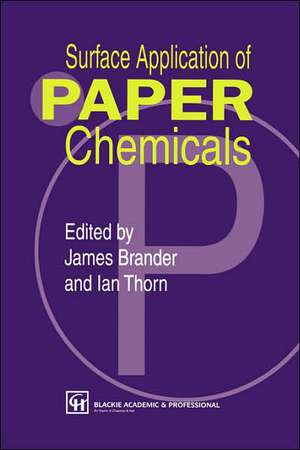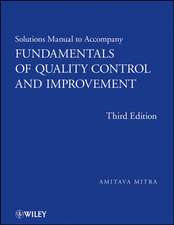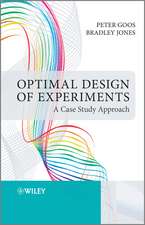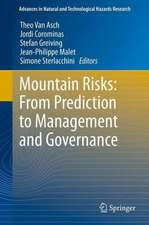Surface Application of Paper Chemicals
Editat de J. Brander, I. Thornen Limba Engleză Hardback – 30 sep 1997
| Toate formatele și edițiile | Preț | Express |
|---|---|---|
| Paperback (1) | 1107.56 lei 6-8 săpt. | |
| SPRINGER NETHERLANDS – 25 dec 2011 | 1107.56 lei 6-8 săpt. | |
| Hardback (1) | 944.28 lei 38-44 zile | |
| SPRINGER NETHERLANDS – 30 sep 1997 | 944.28 lei 38-44 zile |
Preț: 944.28 lei
Preț vechi: 1242.47 lei
-24% Nou
Puncte Express: 1416
Preț estimativ în valută:
180.69€ • 186.41$ • 150.79£
180.69€ • 186.41$ • 150.79£
Carte tipărită la comandă
Livrare economică 22-28 martie
Preluare comenzi: 021 569.72.76
Specificații
ISBN-13: 9780751403701
ISBN-10: 0751403709
Pagini: 263
Ilustrații: XVIII, 263 p.
Dimensiuni: 155 x 235 x 18 mm
Greutate: 0.56 kg
Ediția:1997
Editura: SPRINGER NETHERLANDS
Colecția Springer
Locul publicării:Dordrecht, Netherlands
ISBN-10: 0751403709
Pagini: 263
Ilustrații: XVIII, 263 p.
Dimensiuni: 155 x 235 x 18 mm
Greutate: 0.56 kg
Ediția:1997
Editura: SPRINGER NETHERLANDS
Colecția Springer
Locul publicării:Dordrecht, Netherlands
Public țintă
ResearchCuprins
Background.- Technology of on-machine application.- Chemicals for surface application.- Paper products and surface treatment.- 1 On-machine surface treatment of paper and board with the blade coater.- 1.1 The origins of on-machine surface treatment.- 1.2 The blade-coating system today.- 1.3 Advantages and disadvantages of on-machine surface treatment.- 1.4 Paper and board grades utilizing on-machine surface treatment.- 1.5 Designing the surface treatment line.- 1.6 Examples.- 2 On-machine surface treatment of paper and board with the film press.- 2.1 Introduction.- 2.2 Quality and runnability aspects of different surface sizing processes.- 2.3 New generation film presses.- 2.4 Coat-weight development and metering-element-related phenomena.- 2.5 Film transfer at film-press nip.- 2.6 Precalendering.- 2.7 Control of paper quality.- 2.8 Nip mechanics and roll covers.- 2.9 Quality differences between film-press and blade coated sheets.- 2.10 The SymSizer film press.- References.- 3 Synthetic latex binders for paper manufacture.- 3.1 Introduction.- 3.2 From molecule to particle: latex synthesis.- 3.3 From particles to dispersion: latex stability.- 3.4 The viscosity of latices and coating colors: the novel contribution of the particle state.- 3.5 From particle to film: latex coalescence.- 3.6 From latex to coated paper: the role of polymers in a paper coating.- 3.7 Conclusions.- References.- 4 Starches.- 4.1 Introduction.- 4.2 Principles of starch technology.- 4.3 Starch modification.- 4.4 Surface application methods.- 4.5 Starch properties required for size-press application.- 4.6 Starch properties required for metered size-press application.- 4.7 Starch properties required for blade application and as a coating colour binder.- 4.8 Starch properties required when applied by liquid application system.- 4.9 Size-press starch application to waste-based packaging paper.- 5 Rheology modifiers and pigment dispersants.- 5.1 Introduction.- 5.2 General principles of viscosity and rheology.- 5.3 Flow types encountered in paper surface treatment.- 5.4 Variation of shear stress during surface application.- 5.5 Water retention.- 5.6 Types of rheology modifier.- 5.7 Pigment dispersants.- 5.8 Interactions.- References.- 6 Pigments for on-line surface treatment.- 6.1 Introduction.- 6.2 The pigments.- 6.3 Application.- 6.4 General paper improvement.- 6.5 Conclusions.- References.- 7 Surface sizing.- 7.1 Definition and overview.- 7.2 Chemicals applied at the surface.- 7.3 Function of the products.- 7.4 End-use properties.- 7.5 Interactions and possible problems.- References.- 8 Surface brightening of paper.- 8.1 Introduction.- 8.2 Spectra of different illuminants.- 8.3 The quantification of the effectiveness of fluorescent brightening agents.- 8.4 The chemical nature of fluorescent brightening agents.- 8.5 Application of fluorescent brightening agents to paper.- 8.6 Impairment of fluorescent brightening agents: greening and quenching.- 8.7 Lightfastness.- 8.8 Recycling.- 8.9 Monitoring and control of surface brightened paper.- 8.10 Toxicology and ecotoxicity of fluorescent brightening agents.- 8.11 Summary of the effects and influences on surface addition of fluorescent brightening agents to paper.- Acknowledgements.- References.- 9 On-machine surface coloration.- 9.1 Introduction.- 9.2 Size-press dyeing.- 9.3 Dyes used in on-machine coating.- 9.4 Calender stack dyeing.- 9.5 Spraying.- 9.6 Broke treatment.- 9.7 Survey of surface dyeing.- 9.8 Conclusions.- Acknowledgements.- References.- Further reading.- 10 The surface treatment of fine business papers.- 10.1 Introduction.- 10.2 Non-impact printing.- 10.3 The chemical natures of non-impact printing image-forming materials.- 10.4 Paper requirements for non-impact printing.- 10.5 Surface treatment for non-impact printing papers.- 10.6 Surface application methods.- 10.7 Summary.- Acknowledgement.- References.- Further reading.- 11 Barrier dispersion coating of paper and board.- 11.1 Dispersion coating in general.- 11.2 Film formation.- 11.3 Commonly measured film properties.- 11.4 Heat sealing, blocking and gluing.- 11.5 Products.- 11.6 Disposal of dispersion coated papers.- References.- 12 Recycling surface treated paper products.- 12.1 Introduction.- 12.2 Recycling surface treated paper products.- 12.3 Stock Preparation and the impact of surface treatment chemicals.- 12.4 Summary of the effects of surface treated papers on recycling.- References.












